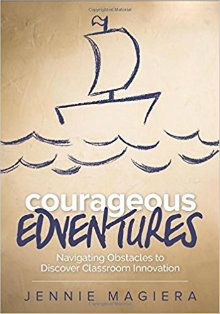Navigating Obstacles to Discover Innovation
Courageous Edventures: Navigating Obstacles to Discover Classroom Innovation
By Jennie Magiera
(Corwin, 2017 – Learn more)

Jennie Magiera compares education today to the time of explorers from over 3000 years ago, where a few adventurers set sail into uncharted waters, despite naysayers, fear of failure and many obstacles. Once the explorers returned, they “shared their discoveries, described the path, and encouraged others to follow them,” (p. xvii) exactly what Magiera is encouraging us to do with this book as a guide to our own edventures.

The book provides a QR code for each chapter and links to the companion site. It is rich with numerous graphics, charts, lists of questions to consider, and references to other books and resources.
Navigate to innovate
Magiera (and others) define innovation as doing things differently to better solve problems. Innovation is not contingent on the use of technology (although tech is often a tool used in this process). She encourages us through 4 sections of the book to “chart a course,” “navigate your problems,” “sail into the great beyond,” and “reflect on your edventure.”
Magiera does a good job of providing discussion and/or resources for topics such as creating a plan, putting students in the driver’s seat, teaching digital citizenship, differentiating instruction, innovating assessment, creating a student owned class culture, accepting failure as a good thing, cultivating student curiosity and voice, and helping students to have an impact on the world through problem-based projects and authentic audiences.
She also addresses how to teachers can grow our own learning through professional networks, traditional and non-traditional professional development, and reflection at every point in the process.
There are many thought provoking nuggets in this book, and I would recommend reading it through first and then going back and picking out the nuggets one at a time. A few examples of these nuggets are teaching students to create “questruns vs. questdones” that will motivate, engage and empower them as they search for the steps of progress toward solutions.
Getting outside our comfort zones
Magiera also discusses a number of new twists to professional development, including that your professional learning network should include those who disagree with you and can push you outside of your comfort zone as well as critical friends to hold you accountable on your journey.
She gives multiple examples of where and how to build your network, including edcamps and a new non-traditional professional development approach she has developed called “Play dates” that allow educators not only to learn about methods or applications, but to take time to “play” with the new learning and collaborate with other educators during the process. Another new twist to professional development is using a 7 day challenge to implement something new.
This is a worthwhile book with lots of supporting resources.
Dr. Laura Von Staden is a Middle School Special Education Lead Teacher in Tampa, Florida. She serves on numerous committees both at her school and within her district, and works closely with the local university where she is a Professional Practice Partner and master mentor. Dr. Von Staden also facilitates both online and face-to-face Professional Development for her school district.


































